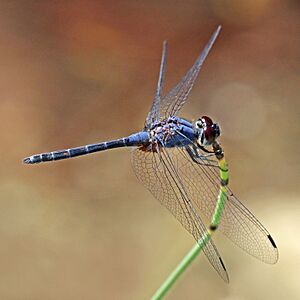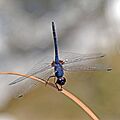Black stream glider facts for kids
Quick facts for kids Black stream glider |
|
|---|---|
 |
|
| Male in Cyprus | |
| Conservation status | |
| Scientific classification | |
| Synonyms | |
|
The black stream glider (Trithemis festiva) is a cool type of dragonfly. It's also called the indigo dropwing. This dragonfly belongs to the Libellulidae family. You can find these dragonflies in many places. They live all the way from Greece and Turkey across Asia to New Guinea.
Contents
What Does the Black Stream Glider Look Like?
The black stream glider is a medium-sized dragonfly. Its body often has a beautiful purple color.
Male Black Stream Glider
Male black stream gliders have a dark purplish-grey color on their front. Their eyes are dark brown on top. They have a purple tint that turns bluish-grey on the sides and bottom. The main part of their body, called the thorax, is black. It's covered with a purple powder-like coating called pruinescence. This makes the thorax look deep blue. Their legs are black.
Their wings are clear and see-through. Each back wing has a dark brown mark near its base. There's also a small black spot at the tip of each wing. The male's belly, or abdomen, is covered with fine blue pruinescence.
Female Black Stream Glider
Female black stream gliders look different from the males. Their front part is brown. Their eyes are dark brown on top and more greyish underneath. The thorax is greenish-yellow or olive-colored. It has a dark brown stripe down the middle of its side. You can also see Y-shaped stripes on their sides.
Their legs are black, but the front part of their front legs is yellow on the inside. Like the males, their wings are clear. They have a dark reddish-brown tip with a black spot. The female's abdomen is bright yellow. It has black stripes down the middle, on the sides, and underneath. These stripes join together on some parts of the abdomen. They form a yellow spot shaped like a wedge.
Where Do Black Stream Gliders Live?
You can often spot black stream gliders near water. They especially like slow-moving streams and canals. These places are often found near thick forests.
They love to rest on big rocks next to streams, rivers, and canals. You might also see them perching on the tips of water plants. They also sit on dried plants or other plants that grow close to the banks of slow rivers or streams.
Images for kids




